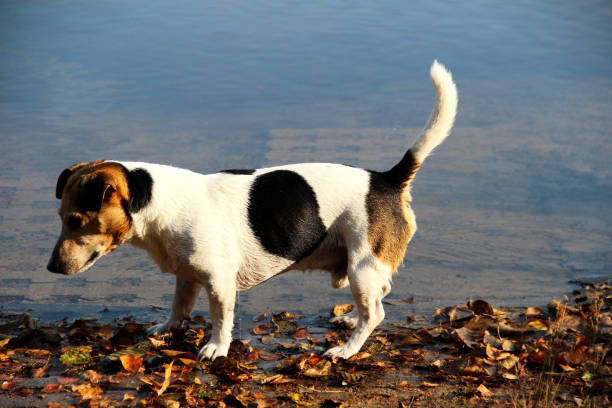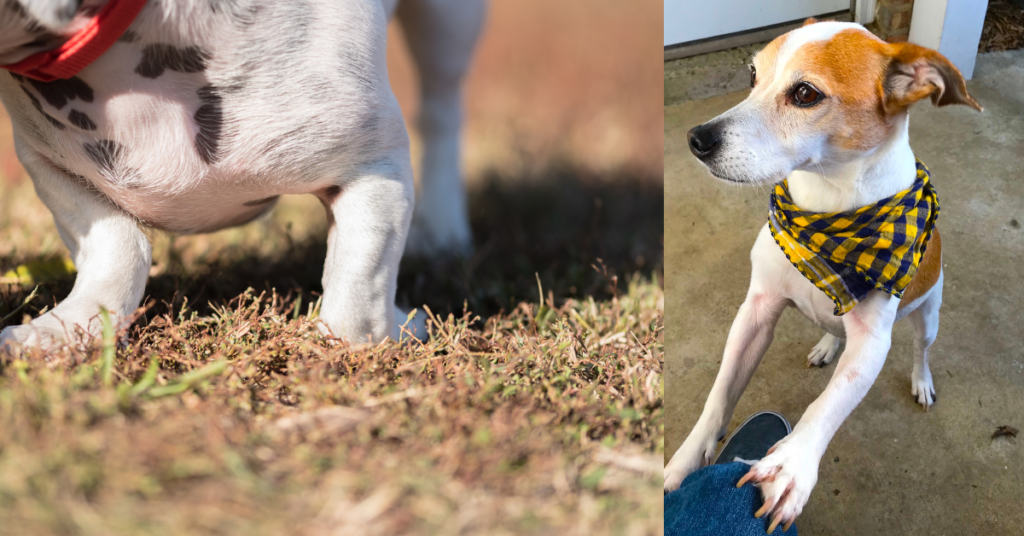The Charm of Short-Legged Jack Russells: Unveiling Their Unique Traits
This post contains affiliate links. This means I will make a commission at no extra cost to you should you click through and make a purchase. Read the full disclosure here.
Jack Russell Terriers are renowned for their spirited personalities, boundless energy, and distinctive appearance. Yet, within this beloved breed, there’s a charming and unique variation known as short-legged Jack Russells. In this blog, we will delve into the captivating world of these endearing canines, exploring their origins, differences from standard Jack Russells, and the allure they bring to the world of dog lovers.
A Brief Overview of Jack Russell Terriers
Before we dive into the enchanting world of short-legged Jack Russells, let’s start with a brief introduction to the Jack Russell Terrier breed as a whole. These terriers are known for their remarkable intelligence, tenacity, and agility. Historically, they were bred to hunt foxes and other small game, and their traits make them versatile and dynamic companions.
Introduction to Short-Legged Jack Russells

Short-legged Jack Russells, sometimes affectionately referred to as “Shorties,” are a unique subset of the breed distinguished by their distinct leg length. While their overall characteristics align with traditional Jack Russells, these dogs possess a special charm due to their shorter stature. This blog aims to uncover the world of short-legged Jack Russells, from their historical roots to their suitability as family pets.
Purpose of the Blog
The purpose of this blog is to provide a comprehensive understanding of short-legged Jack Russells. We will explore their origin story, how they differ from their standard counterparts, the appeal they hold for pet owners, and the joys and challenges of sharing your life with one of these delightful dogs. Whether you’re a seasoned dog enthusiast or considering adopting a short-legged Jack Russell, we hope this guide will offer valuable insights and inspire a deeper appreciation for this unique variation.
In the following sections, we’ll embark on an enlightening journey to unravel the captivating world of short-legged Jack Russells, starting with their fascinating historical background and development.
II. The Origins of Short-Legged Jack Russells

A. Historical Background of the Jack Russell Terrier Breed
To understand the unique characteristics of short-legged Jack Russells, we must first explore the historical roots of the Jack Russell Terrier breed. Named after the Reverend John Russell, an English clergyman and avid fox hunter in the 19th century, these terriers were initially bred for their agility, courage, and hunting prowess.
Rev. Russell sought to create a breed capable of hunting foxes and other small game. His selective breeding led to the development of a small, agile terrier with a keen nose and unwavering determination, traits that continue to define the breed today.
B. Development of the Short-Legged Variation
The short-legged variation of the Jack Russell Terrier is a product of selective breeding. Breeders aimed to preserve the breed’s traditional characteristics while producing dogs with shorter legs. Short-legged Jack Russells share the same lineage and characteristics as their standard counterparts, except for their distinct leg length.
Over time, these dogs gained popularity for their unique appearance and endearing personalities. While short-legged Jack Russells are not recognized as a separate breed by major kennel clubs like the American Kennel Club (AKC), they have a dedicated following among dog enthusiasts who appreciate their distinct charm.
C. The Role of Selective Breeding
Selective breeding played a pivotal role in shaping the short-legged variation. Breeders carefully chose parent dogs with the desired leg length traits, ensuring the continuation of this charming variation. It’s important to note that responsible breeders prioritize the health and well-being of their dogs, in addition to appearance, when practicing selective breeding.
The development of short-legged Jack Russells highlights the breed’s adaptability and the willingness of breed enthusiasts to embrace diversity within the Jack Russell Terrier community. In the following sections, we’ll explore how short-legged Jack Russells compare to their standard counterparts and the unique traits that make them stand out.
II. The Origins of Short-Legged Jack Russells

A. Historical Background of the Jack Russell Terrier Breed
To understand the unique characteristics of short-legged Jack Russells, we must first explore the historical roots of the Jack Russell Terrier breed. Named after the Reverend John Russell, an English clergyman and avid fox hunter in the 19th century, these terriers were initially bred for their agility, courage, and hunting prowess.
Rev. Russell sought to create a breed capable of hunting foxes and other small game. His selective breeding led to the development of a small, agile terrier with a keen nose and unwavering determination, traits that continue to define the breed today.
B. Development of the Short-Legged Variation
The short-legged variation of the Jack Russell Terrier is a product of selective breeding. Breeders aimed to preserve the breed’s traditional characteristics while producing dogs with shorter legs. Short-legged Jack Russells share the same lineage and characteristics as their standard counterparts, except for their distinct leg length.
Over time, these dogs gained popularity for their unique appearance and endearing personalities. While short-legged Jack Russells are not recognized as a separate breed by major kennel clubs like the American Kennel Club (AKC), they have a dedicated following among dog enthusiasts who appreciate their distinct charm.
C. The Role of Selective Breeding
Selective breeding played a pivotal role in shaping the short-legged variation. Breeders carefully chose parent dogs with the desired leg length traits, ensuring the continuation of this charming variation. It’s important to note that responsible breeders prioritize the health and well-being of their dogs, in addition to appearance, when practicing selective breeding.
The development of short-legged Jack Russells highlights the breed’s adaptability and the willingness of breed enthusiasts to embrace diversity within the Jack Russell Terrier community. In the following sections, we’ll explore how short-legged Jack Russells compare to their standard counterparts and the unique traits that make them stand out.

III. Short-Legged vs. Standard Jack Russells
Short-legged Jack Russells, while sharing many similarities with their standard counterparts, exhibit distinct characteristics that set them apart. In this section, we’ll delve into the key differences between short-legged and standard Jack Russells, including physical traits, temperament, and health considerations.
A. Comparison of Physical Characteristics
- Leg Length: The most obvious difference is leg length. Short-legged Jack Russells, also known as “Shorties” or “Shorty Jacks,” have noticeably shorter legs compared to standard Jack Russells. This unique feature adds to their charm and sets them apart at first glance.
- Size: Short-legged Jack Russells tend to be slightly smaller in overall size compared to their standard counterparts. They typically weigh between 9 to 12 pounds (4 to 5.4 kg) and stand about 8 to 10 inches (20 to 25 cm) at the shoulder.
- Body Proportions: Apart from leg length, the body proportions of short-legged Jack Russells are generally similar to standard Jack Russells. They have a compact, muscular build, a strong jaw, and expressive eyes.
B. Behavioral and Temperament Differences
- Energy Levels: Both short-legged and standard Jack Russells are known for their high energy levels and love for play and exercise. However, some short-legged Jack Russells may exhibit slightly lower activity levels due to their smaller size.
- Temperament: The temperament of short-legged Jack Russells closely mirrors that of standard Jack Russells. They are intelligent, independent, alert, and often fearless. Shorties can be equally spirited and confident.
- Trainability: Short-legged Jack Russells are intelligent and respond well to training when done with positive reinforcement methods. However, their independent streak may require consistent training and clear boundaries.
C. Health Considerations
Short-legged Jack Russells generally share the same health concerns as standard Jack Russells. Some common health issues to be aware of include:
- Patellar Luxation: A condition where the kneecap can slip out of place, leading to lameness.
- Lens Luxation: An eye condition where the lens of the eye shifts out of position.
- Hip Dysplasia: A genetic condition that affects the hip joint, potentially causing pain and mobility issues.
- Deafness: Jack Russells, including short-legged ones, can be prone to deafness. Regular hearing checks may be necessary.
While these health concerns are not exclusive to short-legged Jack Russells, responsible breeding practices can help mitigate these risks.
Understanding the differences between short-legged and standard Jack Russells can help you make an informed decision if you’re considering bringing one of these charming dogs into your home. In the next section, we’ll delve into what makes short-legged Jack Russells so appealing to dog enthusiasts.
IV. The Appeal of Short-Legged Jack Russells
Short-legged Jack Russells, often affectionately referred to as “Shorties” or “Shorty Jacks,” possess a unique charm that captivates dog enthusiasts around the world. In this section, we’ll delve into the various aspects that make short-legged Jack Russells so appealing.
A. Charming Appearance and Unique Features
- Distinctive Leg Length: The most obvious and endearing feature of short-legged Jack Russells is their shorter legs. This characteristic gives them an irresistibly cute and whimsical appearance.
- Expressive Faces: Shorties share the same expressive faces as standard Jack Russells, complete with bright eyes, alert expressions, and endearing smiles.
- Compact Size: Their compact size makes them incredibly portable and well-suited for various living environments, including apartments and houses with small yards.
B. Adaptability to Various Living Environments
- Ideal for Urban Living: Short-legged Jack Russells are well-suited for urban living due to their smaller size and adaptability. They can comfortably reside in apartments, provided they receive ample exercise and mental stimulation.
- Great Companions: These dogs form strong bonds with their owners and thrive on human companionship. Shorties are known for their affectionate nature and loyalty.
C. Stories and Experiences from Short-Legged Jack Russell Owners
Countless stories and experiences from short-legged Jack Russell owners highlight the appeal and joy these dogs bring into their lives. Many enthusiasts share heartwarming anecdotes about the unique antics, playfulness, and unwavering devotion of their Shorties.
Short-legged Jack Russells are a testament to the breed’s versatility and adaptability. Whether they’re accompanying their owners on outdoor adventures or snuggled up on the couch for a cozy evening, these dogs have a way of leaving a lasting impression and endearing themselves to their families.
In the following sections, we’ll explore the practical aspects of having a short-legged Jack Russell as a family pet, including their suitability for various households, training and socialization tips, and their exercise and mental stimulation needs.
V. Short-Legged Jack Russells as Companions

Short-legged Jack Russells, with their unique charm and lively personalities, make excellent companions for the right households. In this section, we’ll explore their suitability as family pets, provide training and socialization tips, and discuss their exercise and mental stimulation needs.
A. Suitability as Family Pets
- Active Families: Short-legged Jack Russells are a great match for active families who enjoy outdoor activities, play, and exercise. They are always ready for an adventure, be it a hike, a game of fetch, or a run in the park.
- Social Families: These dogs thrive on human interaction and form strong bonds with their families. They can be affectionate and enjoy being a part of family activities.
- Families with Older Children: Short-legged Jack Russells can get along well with older children who understand how to interact with dogs respectfully. Supervision is crucial, especially with younger kids, to ensure safe play.
B. Training and Socialization Tips
- Early Training: Start training and socialization from a young age. Short-legged Jack Russells are intelligent and respond well to positive reinforcement methods. Consistency and patience are key.
- Socialization: Expose your Shorty to various people, animals, and environments to ensure they become well-adjusted adults. Proper socialization helps prevent fearfulness or aggression in unfamiliar situations.
- Clear Boundaries: Establish clear boundaries and rules from the beginning to prevent unwanted behaviors. Shorties can be strong-willed, so a firm but kind approach to training is essential.
C. Exercise and Mental Stimulation Requirements
- Daily Exercise: Short-legged Jack Russells are high-energy dogs and require at least 30-60 minutes of vigorous exercise every day. Activities like brisk walks, fetch, and interactive games are essential to keep them happy and healthy.
- Mental Stimulation: In addition to physical exercise, provide mental stimulation through puzzle toys, obedience training, and agility courses. These dogs are highly intelligent and need mental challenges to prevent boredom.
- Social Play: Shorties often enjoy interactive play with their owners or other dogs. Playtime not only provides exercise but also strengthens the bond between you and your dog.
In summary, short-legged Jack Russells can be delightful and affectionate family companions when their energy and mental stimulation needs are met. Their adaptability makes them suitable for a variety of living environments, provided they receive the attention, exercise, and training they require.
In the next section, we’ll discuss the grooming and general care needed to keep your short-legged Jack Russell healthy and happy.

VI. Grooming and Care for Short-Legged Jack Russells
Short-legged Jack Russells are relatively low-maintenance when it comes to grooming, but they do require attention to ensure their overall health and well-being. In this section, we’ll discuss how to properly care for your short-legged Jack Russell, including their coat maintenance, dietary considerations, and common health concerns.
A. Coat Maintenance and Shedding Tendencies
- Coat Type: Short-legged Jack Russells have a short, dense, and weather-resistant coat. Their coat colors can vary and often include white with patches of black, tan, or brown.
- Brushing: Regular brushing (once or twice a week) helps remove loose hair, distribute skin oils, and keeps their coat healthy. This also reduces shedding and minimizes the amount of hair around your home.
- Bathing: Short-legged Jack Russells generally don’t require frequent baths. Bathe them when necessary, typically every 1-2 months, or if they get dirty. Use a mild dog shampoo to avoid skin irritation.
B. Dietary Considerations
- Balanced Diet: Provide your Shorty with a well-balanced diet appropriate for their age, size, and activity level. Consult with your veterinarian to determine the best food option for your dog.
- Feeding Schedule: Establish a regular feeding schedule, typically twice a day for adult dogs. Avoid leaving food out all day to prevent overeating.
- Treats and Table Scraps: Limit treats and table scraps to maintain a healthy weight. Excess weight can put strain on their short legs and joints.
C. Common Health Concerns and Preventive Measures
While short-legged Jack Russells are generally healthy dogs, it’s essential to be aware of common health concerns and take preventive measures:
- Patellar Luxation: This condition involves the dislocation of the kneecap and can lead to lameness. Regular veterinary check-ups can help detect and address this issue early.
- Lens Luxation: An eye condition where the lens of the eye shifts out of position. Regular eye exams may be necessary to monitor for this condition.
- Hip Dysplasia: While less common in Jack Russells, it’s still a concern. Maintain a healthy weight and consult your vet for hip joint evaluations as needed.
- Deafness: Some Jack Russells, including short-legged ones, can be prone to deafness. Regular hearing checks can help identify any hearing issues.
Routine veterinary check-ups, a balanced diet, and regular exercise can help mitigate these risks and ensure the overall health and longevity of your short-legged Jack Russell.
By providing proper grooming and care, you’ll keep your Shorty’s coat healthy, maintain their overall well-being, and enjoy a happy and active life together. In the next section, we’ll explore how to find and adopt a short-legged Jack Russell, whether you’re considering buying from a breeder or rescuing one in need of a loving home.

VII. Finding and Adopting a Short-Legged Jack Russell
Bringing a short-legged Jack Russell into your life is an exciting endeavor, but it’s crucial to find the right source and ensure responsible ownership. In this section, we’ll explore the options for finding and adopting a short-legged Jack Russell Terrier.
A. Choosing a Reputable Breeder
If you decide to get a short-legged Jack Russell from a breeder, it’s essential to choose a responsible and ethical breeder who prioritizes the health and well-being of their dogs. Here are some steps to consider:
- Research: Start by researching breeders in your area or those willing to ship puppies. Look for breeders who specialize in short-legged Jack Russells.
- Visit the Breeder: Whenever possible, visit the breeder’s facility in person. This allows you to see the conditions in which the dogs are raised and to meet the puppy’s parents.
- Ask Questions: Interview the breeder and ask questions about their breeding practices, the health of their dogs, and any genetic testing they perform.
- Check References: Request references from previous puppy buyers to gauge the breeder’s reputation.
- Health Records: Ensure the breeder provides health records, vaccinations, and proper documentation for the puppy.
B. Adoption Options and Rescue Organizations
If you prefer to adopt a short-legged Jack Russell, consider rescue organizations and shelters. Many dogs in need of homes can make wonderful companions. Here’s how to go about it:
- Contact Local Shelters: Reach out to local animal shelters, rescue groups, or Jack Russell Terrier-specific rescues to inquire about available short-legged Jack Russells.
- Online Resources: Utilize online platforms, such as Petfinder or Adopt-a-Pet, to search for short-legged Jack Russell Terriers in need of adoption in your area.
- Visit Adoption Events: Attend local adoption events or visit rescue facilities to meet the dogs in person and find the right fit for your family.
- Rescue Criteria: Be prepared for adoption criteria, which may include a home visit, references, and a commitment to responsible pet ownership.
Remember that adopting from a rescue organization can be incredibly rewarding, as you’re providing a loving home to a dog in need.
C. Preparing for a New Short-Legged Jack Russell Puppy
Whether you choose to buy from a breeder or adopt from a rescue, it’s essential to prepare your home for your new short-legged Jack Russell:
- Puppy-Proofing: Puppy-proof your home by removing hazards and ensuring that your yard is secure.
- Supplies: Gather all necessary supplies, including food, water bowls, a collar and leash, toys, grooming tools, and a crate.
- Training Plan: Create a training plan and establish consistent routines to help your new puppy adapt to their new environment.
- Veterinary Care: Schedule a vet appointment for a wellness check-up and vaccinations.
- Patience and Commitment: Be prepared for the challenges and joys of puppyhood. Patience, consistency, and love will help your short-legged Jack Russell thrive.
By responsibly finding or adopting a short-legged Jack Russell Terrier, you can provide a loving and caring home for these charming dogs and experience the joy of their companionship for years to come.
In the concluding section, we’ll summarize the key points of this blog and offer some final thoughts on the charm of short-legged Jack Russells.
VIII. Stories of Short-Legged Jack Russells in Pop Culture
Short-legged Jack Russells have made their mark not only as beloved family pets but also as stars in the world of pop culture. In this section, we’ll explore some famous short-legged Jack Russells who have captured the hearts of audiences in movies, television, and beyond.
A. Eddie from “Frasier”
One of the most iconic short-legged Jack Russells in television history is Eddie, who stole the show in the hit TV series “Frasier.” Played by a dog named Moose, Eddie’s clever antics and distinctive appearance made him a beloved character and a symbol of the breed’s charm. Eddie’s role in the series showcased the breed’s intelligence and ability to steal scenes with their endearing expressions.
B. Max from “The Mask”
Another short-legged Jack Russell who captured hearts on the big screen was Max, Jim Carrey’s trusty sidekick in the movie “The Mask.” Max’s lively personality and expressive face showcased the breed’s endearing qualities and ability to bring humor to the silver screen.
C. Wishbone
Wishbone was the star of the educational children’s television series “Wishbone.” This short-legged Jack Russell portrayed the title character and inspired young viewers to explore classic literature through the adventures of a charming and intelligent dog. Wishbone’s role highlighted the breed’s versatility and appeal to audiences of all ages.
D. Nipper
Nipper, a famous advertising icon, was the model for the RCA Victor trademark. This short-legged Jack Russell became synonymous with the company’s image, with his iconic pose listening to the phonograph. Nipper’s presence in advertising history underscores the breed’s recognizable and endearing appearance.
E. Jack Russells in Sports
Short-legged Jack Russells are often seen participating in dog sports like agility, flyball, and obedience trials. Many have achieved recognition and success in these competitions, showcasing the breed’s intelligence and athleticism. While they may be small in stature, their agility and determination make them fierce competitors.
These famous short-legged Jack Russell Terriers have left a lasting legacy, showcasing the breed’s versatility, intelligence, and charisma. Whether on screen or in real life, these dogs have captured the hearts of many and continue to be ambassadors for their breed.
In the next section, we’ll discuss the conclusion of this blog and provide additional resources for those interested in learning more about short-legged Jack Russells or finding one to welcome into their family.
IX. Conclusion
In this blog, we’ve embarked on a captivating journey into the world of short-legged Jack Russells, uncovering their unique charm, history, and appeal. These endearing canines, with their distinctive leg length and lively personalities, have carved out a special place in the hearts of dog enthusiasts.
From their humble origins as hunting dogs to their starring roles in movies, television shows, and iconic advertising campaigns, short-legged Jack Russells have left an indelible mark on pop culture. Their recognizable appearance and spirited demeanor have made them cherished companions in households around the world.
As family pets, they excel in active and social environments, bringing boundless energy, affection, and a sense of adventure to their owners. Their intelligence and spirited nature make them excellent candidates for training and dog sports.
Whether you’ve been a longtime fan of the breed or are considering adding a short-legged Jack Russell to your family, understanding their characteristics, care requirements, and unique place in popular culture is essential.
In your journey with these charming dogs, remember that each short-legged Jack Russell is a unique individual, ready to share their love, energy, and companionship with you.
X. Additional Resources
For further information and resources on short-legged Jack Russells, consider exploring these additional sources:
- Jack Russell Terrier Club of America: The official website of the breed club offers valuable insights and resources.
- Adopt-a-Pet: An online platform to search for short-legged Jack Russell Terriers available for adoption in your area.
- The Parson Russell Terrier Association of America: The PRTAA provides breed information, breeder directories, and educational resources.
- RCA Victor Trademark History: Learn more about Nipper, the iconic short-legged Jack Russell behind the RCA Victor trademark.
We hope this blog has provided you with a deeper appreciation for the charm and uniqueness of short-legged Jack Russells. Whether you’re a seasoned owner or a prospective pet parent, may your journey with these delightful dogs be filled with love, joy, and endless adventures.
Thank you for joining us in celebrating the remarkable world of short-legged Jack Russells!










![Weaning Jack Russell Terrier Puppies [Tips for how & when to do it successfully] Weaning Jack Russell Terrier Puppies [Tips for how & when to do it successfully]](https://jackrusselterrier.net/wp-content/uploads/2023/03/istockphoto-546184706-612x612-1.jpg)
